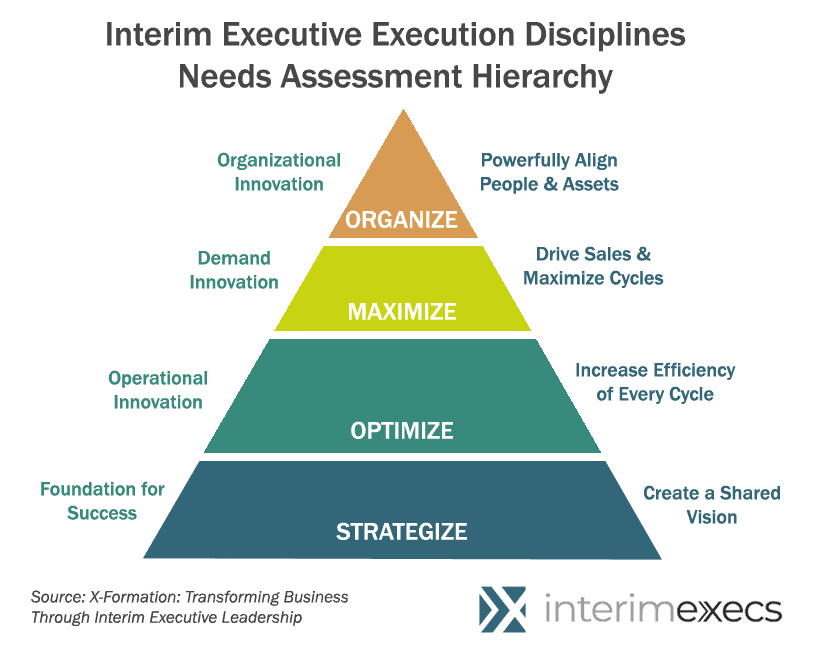We believe talk is cheap, execution is precious and when well done, makes everything sing. Plan execution is why interim executives can be the answer for a company struggling with any sort of transition — from an unplanned vacancy in the C-Suite to unexpected market disruption to the desire to expand to new products, new types of automation, or new parts of the world.
Unlike consultants who come in, assess the situation, develop a strategic plan and leave, interim leaders understand that their job is to shine in the execution phase. Interims are experts at transforming organizations, leading companies through challenges that must be solved to survive and thrive.
Interims approach project objectives using a framework that has them Assess, Plan, and Execute (APE) repeatedly, revising approaches based on the client’s most pressing needs.
Since the stakes are always high, interims come prepared to get started by quickly assessing the health of major functions of the company, working cooperatively with key personnel and team members at all levels of the company to understand the full reality of the situation. Then they develop a project execution plan that will deliver the highest value in the shortest amount of time.
How Can an Interim Executive Help?
Interims can lead a successful project from any corner of the C-Suite.
Interim Chief Executive Officers take over the top spot, focusing on implementation and execution across the enterprise, knowing they will be held to account for the successful project management plan. They are experienced leaders who can handle all aspects of corporate leadership, from creating a strategic plan to overseeing individual tasks such as developing the communication plan that will help each project team understand the project tasks, deliverables, and metrics.
Interim Chief Marketing Officers or Chief Sales Officers are engaged to solve revenue and sales problems. With skills that range from brand positioning to social media, they are adept at telling a compelling story to customers and the marketplace.
Interim Chief Operating Officers are real-time executive change agents laser-focused on aligning resources, people, and assets to get the mission accomplished.
Interim Chief Financial Officers are hands-on financial experts. They are experienced financial experts who can rescue a company that has run out of runway or oversee the life-cycle of financial operations for companies that simply need a steady hand on the tiller.
How Interim Executives Execute
The needs of a typical organization can be broken down into four major areas, each of which interims approach from the perspective of “execution.”
The following diagram illustrates the four execution disciplines interims practice throughout the planning process to assess needs, take action, and achieve milestones.
Strategize
Volumes have been written on strategy and strategy development, but what is often neglected in the discussion is execution. Strong strategy forms the basis of transformation, creating a clear vision for the company. While execution trumps strategy in the abstract, excellence in execution starts with sound strategy.
Experienced interim executives bring with them substantial experience in strategy development and the unique perspective that comes through repeatedly stepping into organizations and seeing the real-world challenges that arise in executing said strategy.
Read the full post to learn the reasons your business strategy is failing and how a interim executive can help.
Optimize
Optimization is the discipline of driving efficiency and reducing below-the-line expenses to increase bottom-line performance.
Interim executives help organizations optimize their operations by eliminating redundancy and inefficiency through process assessment, resource allocation, project management, and innovation. They are experienced at understanding project scope, focusing initiatives on key performance indicators, determining deliverables, and achieving project goals.
Read the full post to learn more about business optimization and how interims do it right.
Maximize
Maximization efforts are focused on driving sales and increasing bottom-line performance by growing the top line. Maximization yields the highest return to an organization by creating more volume to be served by efficient processes.
Interim executives help organizations address challenges of growth, profitability, and scale to drive revenue growth by engaging all of the project stakeholders. That can require skills as varied as risk management, resource allocation, and project scheduling, to achieve KPIs.
Read the full post to learn how interim executives can help you maximize top line growth.
Organize
The key to fulfilling the three objectives outlined above is aligning all resources in a company around the strategy and core processes.
Interims have the outside perspective needed to properly align the company’s people, assets, and processes around its strategy and plan execution.
Read the full post on how interim executives organize using strategic alignment.
Contact InterimExecs to learn more about how an interim executive from InterimExecs RED Team can help solve your biggest challenges, opportunities, and leadership gaps.
———————————
This article draws on the chapter “The Interim Executive Approach” featured in X-Formation: Transforming Business Through Interim Executive Leadership, a guide to interim management written by several veteran executives on InterimExecs RED Team.
The needs of a typical organization can be broken down into four major areas, each representing an execution discipline interims practice to assess needs and take action. See all four parts of the series: Strategize, Optimize, Maximize, and Organize.






